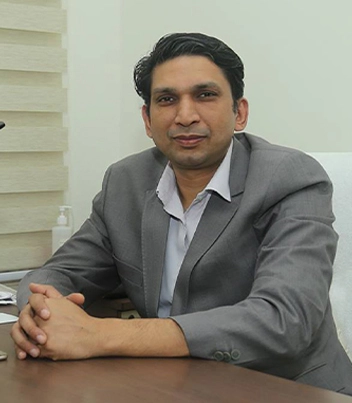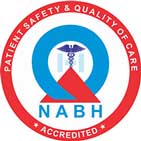
Bone Fracture Surgery Hospital in Jalandhar
Connect with the best Bone Facture Doctor in Jalandhar at HP Orthocare.
What Is Bone Fracture Repair (SURGERY)?
When a bone breaks (also known as a fracture), it is critical that the bone heals properly in its original location.
There are several treatments for a broken bone, and the one a doctor recommends is based upon several factors. These include how severe the break is and where it is.
While some bones can heal by wearing a cast, others may require more invasive treatments, such as bone fracture repair.
Bone fracture repair is surgery to fix a broken bone using metal screws, pins, rods, or plates to hold the bone in place. It’s also known as open reduction and internal fixation (ORIF) surgery.

Dr. Soneet Aggarwal
MBBS, MS(ORTHO), ISAKOS Awardee, Ex. Register: PGIMS
Why Is Bone Fracture Repair(Surgery) Done?
Bone fracture surgery is used when a broken bone doesn’t or wouldn’t heal properly with casting or splinting alone.
Improper healing that requires ORIF surgery can occur when the bone fracture is open through the skin (compound fractures) and fractures that involve joints, such as wrists and ankles.
It could severely impact a person’s functional mobility if they didn’t repair bones surrounding the joints.
Bone Fracture Healing
Our body reacts to a bone fracture by protecting the injured area with a blood clot and callus or fibrous tissue. As a result, bone cells begin forming on either side of the bone fracture line. These cells grow towards each other and thus close the fracture.
Medical Therapy
Early fracture management aims to control bleeding, prevent ischemic injury (bone death), and remove sources of infection, such as foreign bodies and dead tissues. The next step in fracture management is the reduction of the fracture and its maintenance. It is essential to ensure that the active part of the body returns to its function after the fracture heals. Either non-operative or surgical methods do maintenance of fracture reduction with the immobilization technique.
Non-operative (closed) therapy comprises casting and traction (skin and skeletal traction).
Casting
Closed reduction is made for any fracture that is displaced, shortened, or angulated. Splints and casts made of fiberglass or plaster of Paris material are used to immobilize the limb.
Traction
The traction method manages fractures and dislocations that cannot treat by casting. There are two traction methods, namely, skin traction and skeletal traction.
Skin traction involves the attachment of traction tapes to the skin of the limb segment below the fracture. A pin is inserted through the bone distal to the fracture in skeletal traction. Weights will be applied to this pin, and the patient will be placed in an apparatus that facilitates traction. This method is most commonly used for fractures of the thigh bone.
Why Choose Dr. Soneet Aggarwal at HP Orthocare?
- HP Orthocare is Covid safe – The patient’s safety comes first here and is mainly taken care of by social distancing and sanitized clinics besides sterilized hospital rooms.
- Our team of doctors is fully vaccinated.
- Post-surgery care – We tend to offer fantastic follow-up sessions, including consultations and instructions like dietary tips and physiotherapy, to all patients to ensure you have a seamless recovery.
Surgical Therapy
Open Reduction and Internal Fixation (ORIF)
This surgical method involves adequately exposing the fracture site and reducing the fracture. Kirschner wires, plates, screws, and intramedullary nails are used for internal fixation.
Closed Reduction And Internal Fixation
Fracture reduction is made in this technique without opening the fracture site, usually using intramedullary nails
External fixation
External fixation is a procedure in which fracture stabilization is done at a distance from the fracture site. It helps to maintain bone length and alignment without casting.
External fixation is performed in the following conditions:
- Open fractures with soft-tissue involvement
- Burns and soft tissue injuries
- Pelvic fractures
- Comminuted and unstable fractures
- Fractures having bony deficits
- Limb-lengthening procedures
- Fractures with infection or non-union
Rehabilitation
Fractures may take several weeks to months to heal completely. Therefore, you should limit your activities even after removing the cast or brace so that the bone becomes solid enough to bear the stress. Rehabilitation programs involve exercises and a gradual increase in activity levels until the healing process is complete.
To schedule an appointment with our best surgeon Dr. Soneet Aggarwal, please call +91 98144-18335 or request an appointment here.
Bone Fracture Hospital In Jalandhar (FAQ)
The most common causes of bone fractures are trauma due to sports, exercise, a bad fall, or a vehicular accident. Joint overuse and misuse can also cause fractures. While your bones have some flexibility, too much stress can cause them to break. For the elderly, osteoporosis is a major contributing factor to bone fractures.
Incomplete and non-displaced fractures may heal on their own. However, you must see a doctor to get a proper diagnosis. The Doctor may need to immobilize the area to ensure appropriate alignment and lack of disturbance as your bone heals. Displaced fractures need to be realigned and immobilized. For bone fractures that have broken into many pieces, the Doctor may need to perform surgery and realign the parts using artificial components to hold them together. Consult Dr. Soneet Aggarwal at HP Orthocare for the best care.
Prevention of fractures:
It is always advisable to wear protection while participating in adventurous activities/driving. The protection can be in helmets, elbow pads, knee pads, and shin pads. The first and foremost thing to prevent fractures is to ensure a safe atmosphere. Stairways should be gated. Any liquid spilled should be swabbed, and the area must be wiped dry.
The use of handrails on staircases and non-skid mats near bathrooms and other places is recommended. It is especially valuable in a house with elders. Teach children about safety and supervise them carefully. No substitute for supervision exists, no matter how safe the environment or situation appears. Prevent falls by not standing on chairs, countertops, or other unstable objects.
The causes of a fracture can be varied.
- Trauma: A traumatic incident, such as a fall, a vehicle accident, or a sporting injury, is one of the most common causes of a fracture.
- Medical Conditions: Diseases like osteoporosis weaken the bones, making them likelier to suffer cracks or breaks. Patients affected by osteogenesis imperfecta can experience bone fractures very frequently. Such fractures are generally termed pathological fractures.
- Repetitive motion: Constant movement can tire the muscles, thus exerting more force on the bones, which may lead to stress fractures. Such fractures are most commonly observed in sports professionals.
If a person is diagnosed with osteoporosis, they should immediately consult a doctor. The patients have often been prescribed medications like bisphosphonates, estrogen agonists/antagonists, parathyroid hormone, estrogen therapy, and hormone therapy.
Most fractures can heal by themselves. Still, fractures need medical intervention for your bones to heal.
Strength training may help you to strengthen your bones. Keep your rooms well-lit, and use a skid-free mat to avoid falls.
Fractures happen when the force applied is to a great extent, and the bones cannot withstand it anymore. When bones are twisted, they break.
They break when an external force is applied so the bone cannot withstand it. The fractured bone disturbs the structure and strength of the bone and causes pain and swelling.
When a bone is healed, it is strong enough to allow you to return to your normal level of function. You will see proper balance, flexibility, and strength at the fracture site. However, an x-ray is the only way to ensure that your fracture has healed.
The amount of time it takes to heal a bone depends on the fracture type and the break’s location. In addition, age, overall health, and whether or not a person smokes can all impact recovery. Children, for example, heal faster than adults because they have a surplus of growth hormones. On the other hand, smokers’ bones can take up to twice as long to recover due to decreased blood supply to the damaged site.
It varies on the bone and the fracture type, but with proper rest and care, most fractures heal in 6-8 weeks. However, this time frame could be longer or shorter depending on the fracture type and other factors such as age and overall health.
It is common to feel discomfort for a short time after a broken bone has recovered. However, in some situations, the pain continues for months or even years after healing is complete.
When someone complains of prolonged discomfort in a fractured location, it is usually the result of arthritis or degenerative changes. Seek the advice of the best orthopedic surgeon or other specialists.


